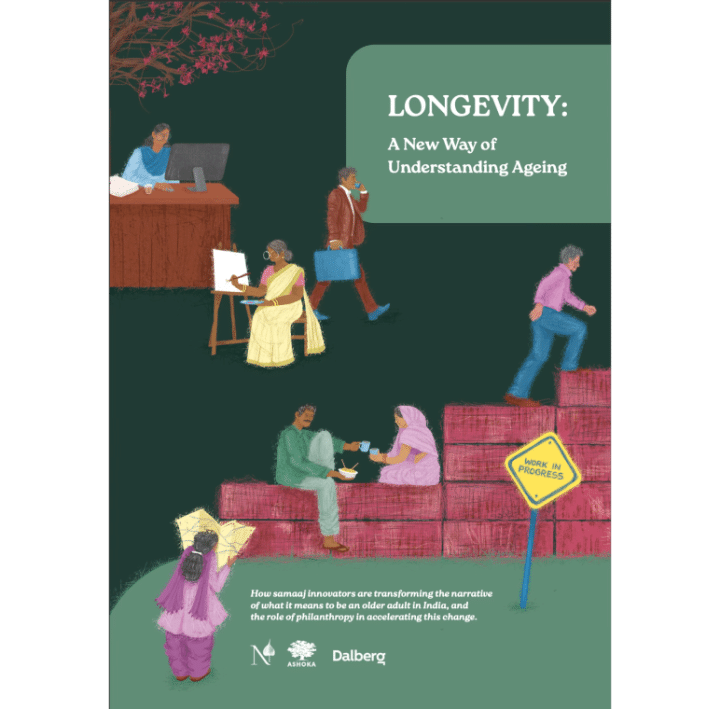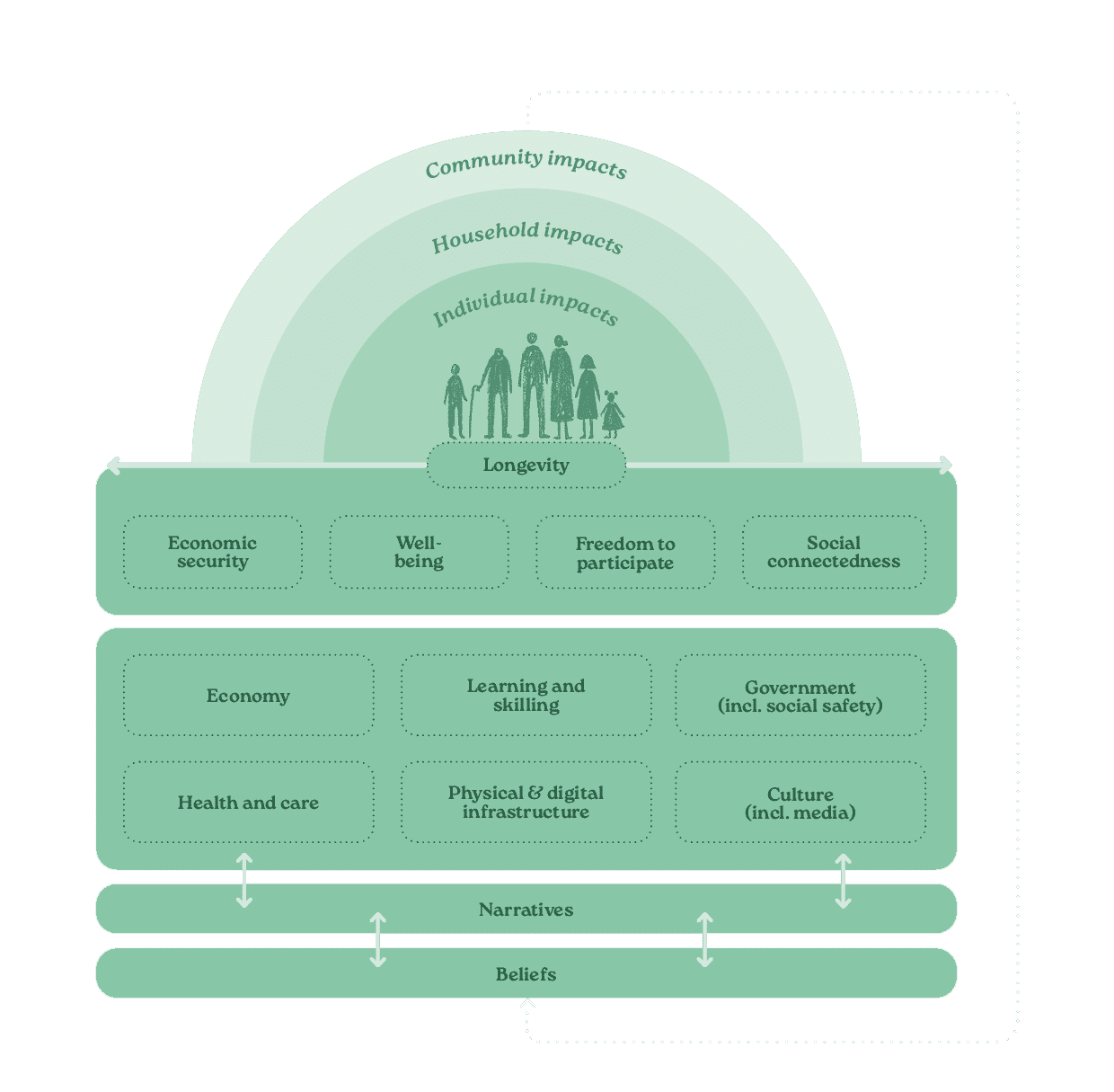About Longevity: A New Way of Understanding Ageing
This report explores India’s demographic shift through the lens of longevity, reframing ageing as a source of innovation and opportunity. With the older adult population set to double to 300 million by mid-century, India must redesign its systems—social, economic, and healthcare—to ensure that people of all ages can thrive with purpose and connection.
Drawing insights from 37 civil society innovators, we map key trends, highlight solutions, and explore the evolving role of caregivers. More than a study, this report is a call to action: to build an inclusive, intergenerational future where longevity is not just about living longer, but about contributing, engaging, and shaping society at every stage of life.


The traditional definition of longevity is simply an increased lifespan. Many research efforts, especially in the scientific community, are focused on extension of life for longevity.
However, we adhere to a more holistic definition that focuses on the quality of life in those years. In other words, longevity emphasises not just the number of years lived for an individual but also encompasses overall well-being, and self-determined participation of individuals of all ages, throughout their lifespan.
This is especially relevant for India, where given cultural, religious and spiritual traditions which often embrace end of life. We believe longevity span four conditions, which collectively add up to what older adults say they want most from their lives: freedom, security and well-being.
This report explores five main areas...
1. Embracing Today, Preparing for Tomorrow: The Need to Reimagine and Build for a New Future
a)India is undergoing a profound demographic shift—one that deserves immediate attention.
Driven by improvements in healthcare, economic growth and education, and their consequent impacts on life expectancy and birth rates, India is shifting from being one of the world’s youngest societies to the world’s oldest.
b)Such a transformation requires us to reimagine what India’s future looks like. Our thinking needs to be expansive across all spheres of society, and we must learn from innovative examples from other countries.
c) This is an opportune moment to make investments in this new future.
d)Prioritising these investments can drive immense benefits not just for older adults, but for the entire country.
e)Unpacking what we mean by “longevity”
2. Blessings and Burdens: The Lived Reality of India’s Older Adults
a) Older adults across India are redefining what it means to grow older.
Millions of older adults across the country are bucking established norms associated with growing older, such as retiring from work and public life. They are combining their experience, knowledge and wisdom with innovations in digital technology, social media and the increase in the number of platforms to explore their aspirations to build more meaningful and vibrant lives for themselves. The data is sparse and research is still emerging, but we are seeing the following
b) In urban India, older adults are increasingly pursuing second careers, engaging in community activities, and taking up new hobbies.
c) In rural areas, older adults are sustaining community practices while adopting new technologies and ideas.
d) These stories are positive and encouraging, but not yet the norm. Across the four dimensions of longevity, most older adults in India experience challenging life circumstances.
e) Some groups of older adults face more severe inequalities and hardships.
f) Finally, the status quo is also untenable for many older adults’ caregivers.
3. Freedom, Security, and Well-being: A New Narrative for Longevity
a) Families consider caring for older adults their filial duty and older adults want to stay with their children and grandchildren.
India’s approach to caring for older adults differs significantly from Western nations. While Western countries emphasise individual independence and provide state-supported senior care infrastructure, in India, growing older is associated with interdependence where the family is typically seen as responsible for care as people age. This perspective is reinforced by religious texts across faiths that equate parent care with divine service and position elderly family members as custodians of tradition and wisdom.72 This cultural outlook persists today, with 75% of older adults and 84% of caregivers believing that families should be responsible for the care of older adults. Limited social security benefits and senior care facilities further reinforce this family-centred model. Although urbanisation and work-related migration are gradually influencing these attitudes, the fundamental expectation of children providing physical and financial support for ageing parents remains ingrained in Indian society.
b) Cultural beliefs also emphasise growing older as a time for older adults to seek spiritual wisdom over material pursuits.
c) Older adults and their families often eschew actions like engaging in preventive health and participating in public life.
d) These narratives are limiting and collectively holding us back from recognising the immense contributions that older adults are making to society.
e) A new narrative would anchor on the notion that growing older can and should mean what older adults want it to mean.
4. Ignition but Awaiting Lift-off: How Samaaj is Shifting the Narrative
a) A large and vibrant samaaj is hard at work to improve the quality of life of older adults.
The NITI Aayog Darpan portal lists more than 39,000 voluntary or non-governmental organisations (NGOs) that are focused on supporting older adults. Apart from these NGOs, there is a diverse group of samaaj organisations including faith-based organisations, social enterprises, formal and informal citizen groups, and academia that are leading efforts to improve the quality of life for older adults. They are effectively leveraging their proximity to communities (e.g., NGOs) and trust among older adults (e.g., in faith-based organisations). The freedom to pilot and innovate (e.g., for social enterprises) is enabling them to drive efforts across all four dimensions that define the quality of life of older adults. Since they are at the forefront of many shifts in this sector, we are collectively terming this group the samaaj innovators (SIs).
b) Sarkaar: Embracing longevity in policy action
c) Bazaar: A new wave of entrepreneurial activity targeting older adults
5. Sparking change: Bold Ideas for Samaaj to Mainstream Longevity
a) There are three opportunity areas that samaaj innovators can pursue.
Based on an understanding of where older adults are today, the gaps that exist in the ecosystem and input from several experts, we have identified three areas to strengthen the longevity ecosystem in the country.
b) Caregiving: An opportunity for philanthropy to support integrated solutions for older adults and all of society.





